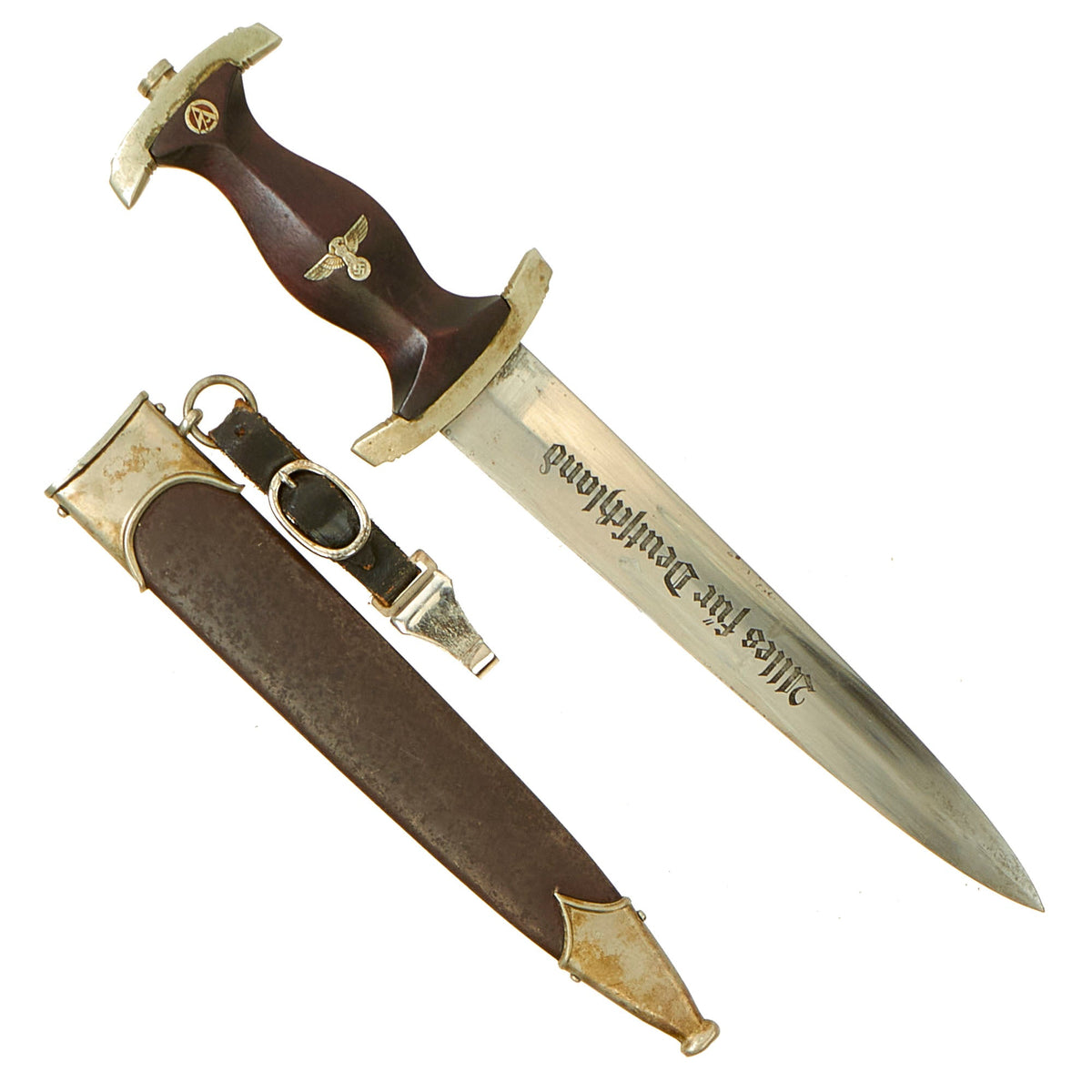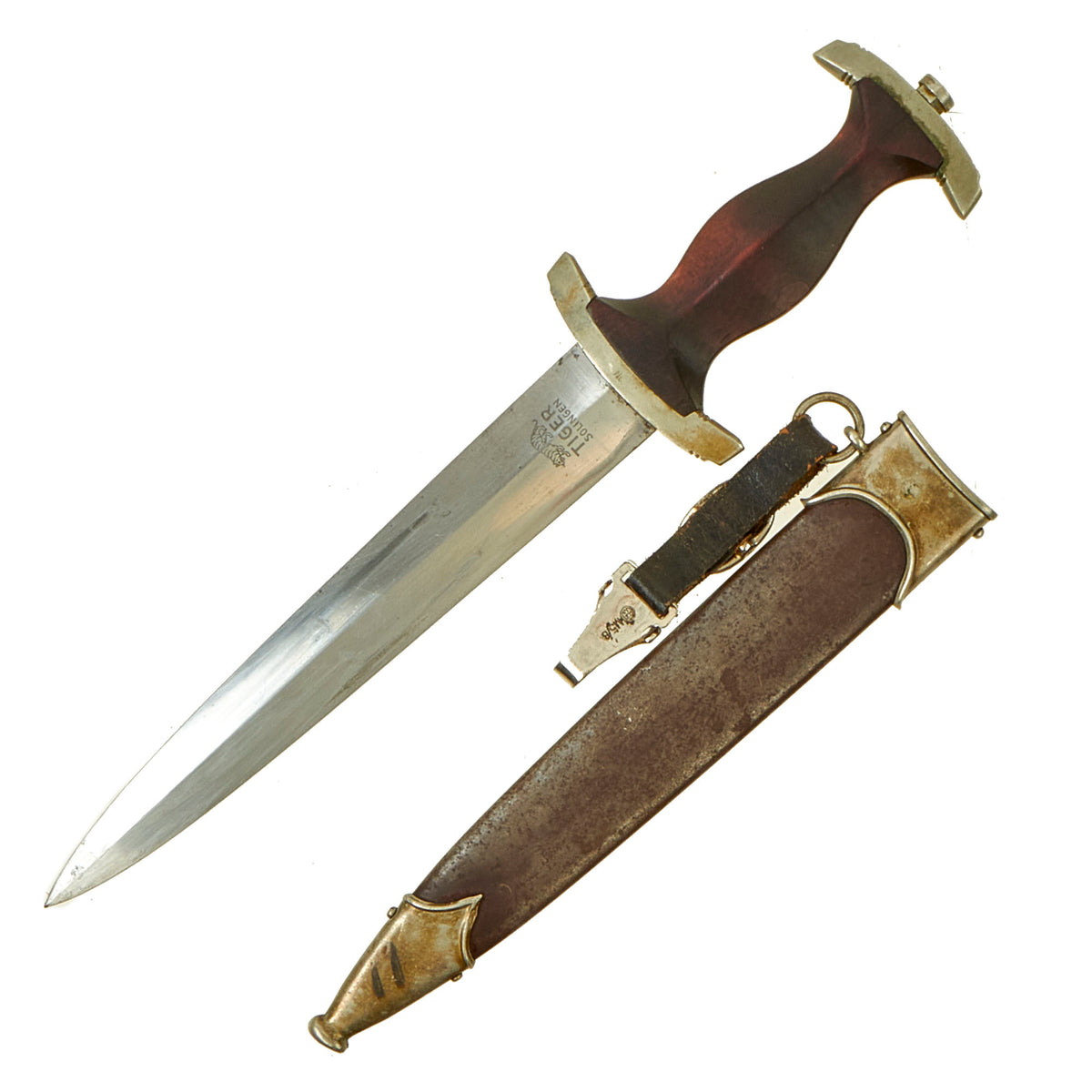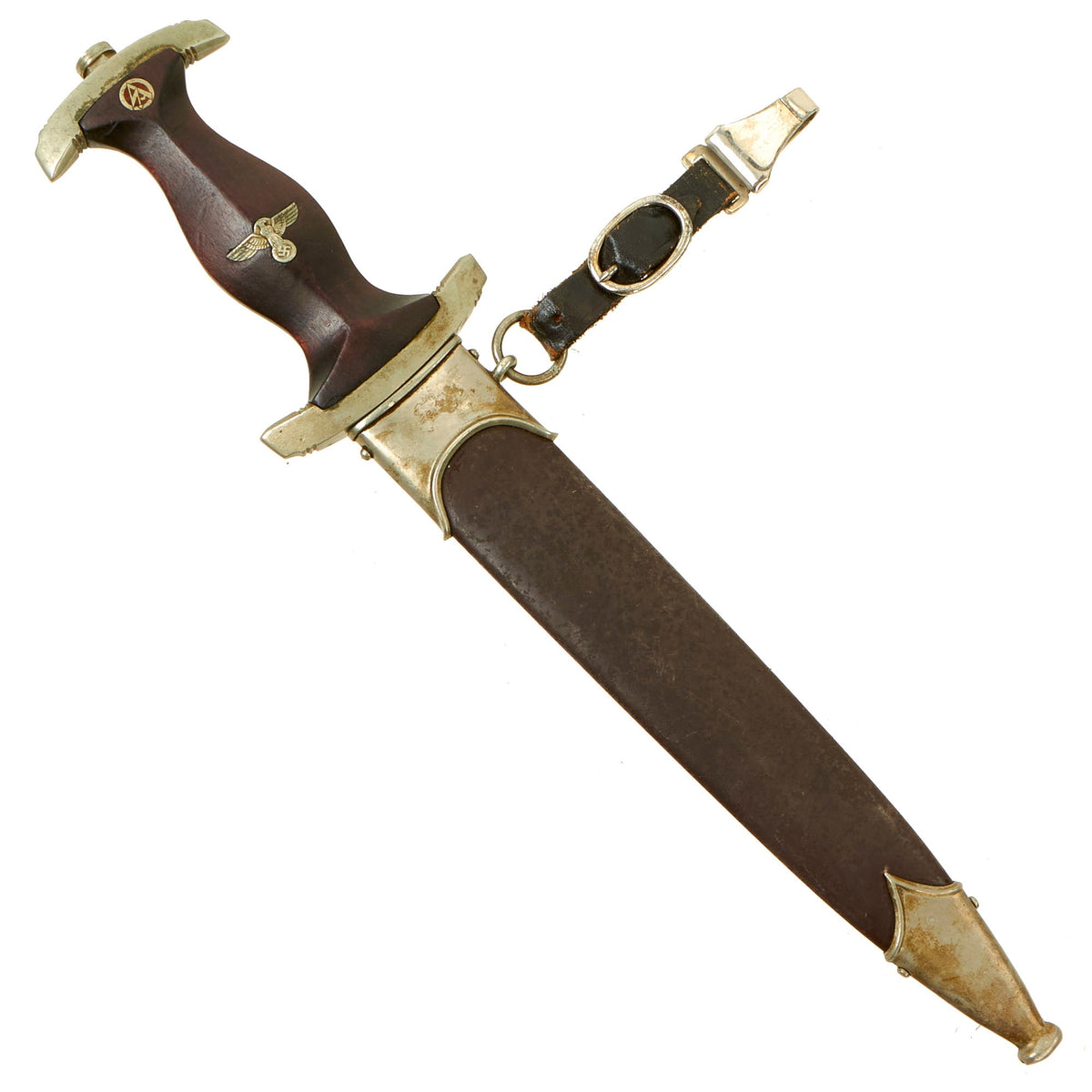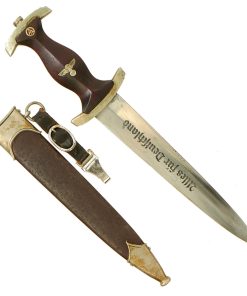Original German Early WWII SA Dagger by Tigerwerk Lauterjung & Co. of Solingen with Scabbard & Belt Hanger Original Items
$ 995,00 $ 248,75
Original Item: Only One Available. This is a lovely early pattern SA Dagger, made by Lauterjung & Co., Tiger Stahlwaren- und Waffenfabrik in Solingen, Germany. It comes complete with the original scabbard, as well as a very nice leather belt hanger. The dagger has solid nickel silver fittings throughout, and is a really nice example. The cross guards and tang nut are in very good condition throughout with all fittings having a nice aged patina. There is a bit of oxidation by the grip, caused by the dyes used and moisture. The lower reverse guard is Gruppe/Gau marked Ns, for Niedersachsen (Lower Saxony) a district in north central Germany, with the principal city being Hannover. This feature was only seen on daggers produced 1935 and prior.
The grip is a fine product having a nice dark red brown color, with a medium center ridge construction. There is some light wear and pressure denting, and there are cracks on both sides by the pommel guard, which is relatively common. It fits the crossguards nicely, though there is a bit of wobble as the wood has shrunk over the decades. The symbol button is nicely set, and still has almost all of the translucent enamel intact, though there is some oxidation of the nickel, as well as some cracking of the wood around it. The grip eagle is a fine example being the style with beak that points straight. Most of the details are still there to the eagle to include the beak, breast feathering, wing feathering, talons, wreath and mobile swas. There is a bit of wear and verdigris, showing that is the correct solid nickel silver for an early pattern eagle.
The blade of this example is in very good condition, with the factory final polish grind cross grain retained on much of the blade. This texture is iconic, and is the definitive identifying characteristic for a real WWII German Blade. There are some areas of past oxidation, some now polished away, which has made the grain a bit faint in areas. There is also the usual runner wear, which is impossible to avoid. The acid-etched Alles für Deutschland (Everything for Germany) SA motto is crisp, and still retains almost all of the factory darkening!
The reverse ricasso is marked with the “Left Facing Tiger” trademark of the Lauterjung & Co. firm, and to the right of the trademark is:
TIGER
SOLINGEN
Lauterjung & Co., Tiger Stahlwaren- und Waffenfabrik is a famous manufacturer in Solingen, the legendary “City of Blades” in Western Germany. Their trademark was a Tiger, and their factory was thus often referred to as Tigerwerk (Tiger Works). The firm was founded in 1873 to make knives, scissors, and other steel ware, and survived until after the war. There were several different branches of the Lauterjung family involved in edged weapons, operating under different trade names to avoid confusion. For more information please see GERMAN KNIFE AND SWORD MAKERS by J. Anthony Carter.
The scabbard shell is straight throughout and is the early-war style, which was originally “anodized” brown and then lacquer coated to protect it. On this example the lacquer is almost completely removed, with just a few remnants near the fittings, and the anodized finish has mostly been removed, replaced with an oxidized patina. This still does however show much of the original brown hue. The upper and lower fittings are solid nickel silver, and have a nice patina, with some dents and scratches showing typical wear. The bottom fitting is dented in and split along the brazing seam, typical of the softer nickel alloy. The throat nicely matches the cross guards and the screws for the top and bottom mounts are still present.
Attached to the hanger ring on the scabbard is a very nice later pattern belt hanger, with plated steel hardware and black finished leather, so it may be for an NSKK dagger. The leather is in good condition, showing a wear and cracking to the finish, as well as some leather tearing. The plated steel clip on the end is marked with (RZM) code M5 / 8 for F. W. Assmann & Söhne of Lüdenscheid, a German city known for it’s clothing accessories industry. This maker is particularly well known, and had other factories as well.
A lovely early war SA dagger by a very desirable maker, complete with the original scabbard and belt hanger. Ready to display!
Specifications:
Blade Length: 8 3/4″
Overall length: 13 3/4”
Crossguard: 3”
Scabbard Length: 10”
History of the SA-
The SA or Brown Shirts, were a private political formation which Adolf AH and the NSDAP used to maintain order at organized Party meetings and demonstrations. The group was formed in 1921, and grew to a huge force of nearly 3,000,000 men by the later 1930’s. To instill esprit de corps, as well as create employment for the Blade City of Solingen, it was decided each SA man would carry a dagger with his Brown Shirt uniform. Huge quantities needed to be produced to accommodate the demand. The dagger initially was produced of hand-fitted nickel mounts with attractive finished wood grip and brown anodized (a bluing process) finished scabbard.
The blade was etched with the SA motto, Alles für Deutschland. Examples produced prior to 1935 were stamped with the German sector of the SA group on reverse lower crossguard. Later examples underwent standardization through the RZM ministry. These pieces were produced of cheaper plated zinc-base fittings and scabbards were simply painted brown.
Prior to his “unmasking” as a traitor, Ernst Röhm was the leader of the SA. In 1934, he distributed approximately 100,000 SA daggers with his personal inscription on the reverse blade. These daggers were to honor individuals who had served with the SA prior to December, 1931. Other than the inscription, these pieces were identical to the standard M1933 SA dagger. After the Röhm purge, the inscription was ordered to be removed. Many examples were returned to the factory for grinding. Others were simply ground in the field by whatever means were available. Examples will occasionally be encountered with remnants of the original inscription remaining on the blade, but mostly none will remain. Some blades exist with an intact inscription, reflecting only the removal of the Röhm signature. Very very rarely is an example seen with a full, untouched inscription, as the holder would have surely risked a charge of treason.
Fast Shipping with Professional Packaging
Thanks to our longstanding association with UPS FedEx DHL, and other major international carriers, we are able to provide a range of shipping options. Our warehouse staff is expertly trained and will wrap your products according to our exact and precise specifications. Prior to shipping, your goods will be thoroughly examined and securely secured. We ship to thousands clients each day across multiple countries. This shows how we're dedicated to be the largest retailer on the internet. Warehouses and distribution centres can be located throughout Europe as well as the USA.
Note: Orders with more than one item will be assigned a processing date depending on the item.
Before shipping before shipping, we'll conduct a thorough inspection of the items you have ordered. Today, the majority of orders will be delivered within 48 hours. The delivery time will be between 3-7 days.
Returns
The stock is dynamic and we cannot completely manage it because multiple stakeholders are involved, including our factory and warehouse. So the actual stock may alter at any time. It's possible that you may not receive your order once the order has been made.
Our policy is valid for a period of 30 days. If you don't receive the product within 30 days, we are not able to issue a refund or an exchange.
You can only return an item if it is unused and in the same state as the day you received it. You must have the item in its original packaging.
Related products
Uncategorized
Uncategorized
Uncategorized
Uncategorized
Uncategorized
Angolan Rebel 1970s era 60mm Inert Display Mortar from Angolan Civil War Original Items
Uncategorized
Uncategorized
Uncategorized
Armored Burgonet Helmet & Polearm from Scottish Castle Leith Hall Circa 1700 Original Items
Uncategorized
Australian WWII Owen MK1 Machine Carbine SMG Custom Fabricated Replica with Sling Original Items
Uncategorized
Uncategorized
Uncategorized
Uncategorized
Uncategorized
Uncategorized
Uncategorized













































































